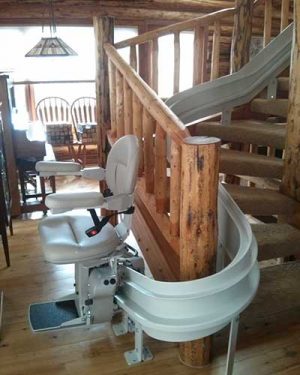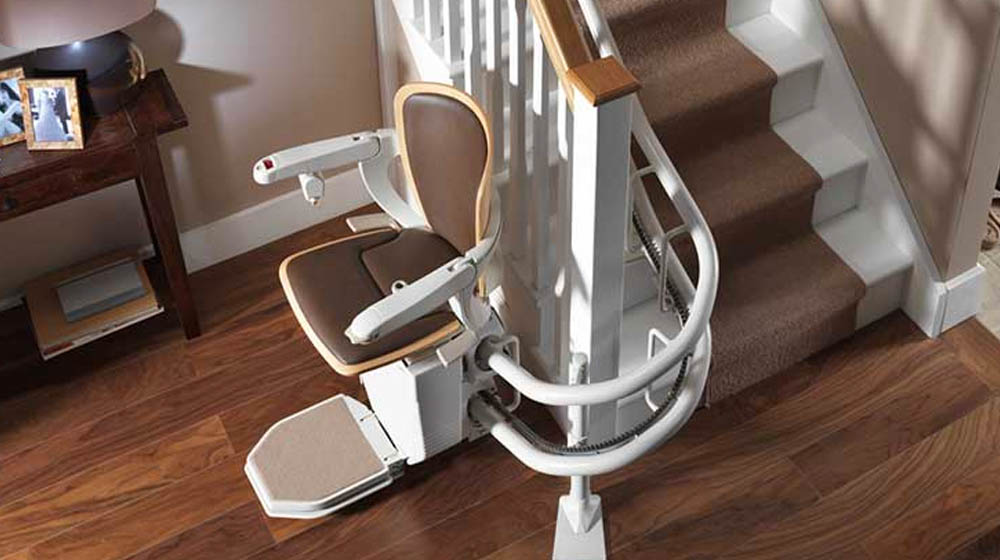A survey conducted by Retirement Living revealed that over 80 percent of Americans aged 55 and older wished to remain living independently in their own homes for as long as they can. This preference among the elderly population to age in place necessitates appropriate modifications be made to their homes to make them as safe as possible.
For those with limited mobility, stair lifts serve as essential equipment in this trend toward home modification. Installation of a stair lift enables them to move around their multi-level home easily, allowing them to continue living independently, and reducing worry among themselves and family members. A variety of stair lift types exist, which can be built into a myriad of configurations to meet the needs of consumers.
Types of StairLifts
The main types of stair lifts are straight, curved, outdoor (straight or curved), standing (straight or curved), and platform. Each type of stair lift is intended to interact with a certain type of staircase or other situations in which the consumer requires a certain type of mobility.
-
Straight Stair Lift: A straight stair lift is the simplest and most inexpensive type of stair lift. This stair lift is installed directly along the side of a completely straight staircase. Some common benefits and features of straight stair lifts include the ability to be installed on either side of a staircase, a retractable rail and seat, and footrest and armrests that fold up when not in use. Straight stair lifts often have the option of a power swivel so you can be automatically and securely moved to the landing at the top of the stairs.
-
Curved Stair Lift: A curved stair lift is customized to your individual staircase since it follows the unique curve of the staircase. As a result, this type of stair lift is considerably more costly. Curved stair lifts can conform to a myriad of specific requirements, such as staircases that encompass multiple floors, staircases with a landing between floors, and even complex spiral staircases. Like straight stair lifts, curved stair lifts are also typically equipped with a foldable seat, footrest, and armrests and either a power swivel option or the ability to stop directly on a landing. Easy-to-use and intuitive controls are also standard.
-
Outdoor Stair Lift: An outdoor stair lift can be either straight or curved, depending on the specifications of your outdoor staircase. This type of stair lift is designed to be resistant to adverse weather conditions and temperature extremes and is most often used for transportation to and from a porch, deck, driveway or detached garage or shed. Outdoor stair lifts usually have a foldable seat, a seat belt, and a power swivel option, in addition to unique outdoor features such as a lock-and-key to keep them secure and a cover to keep them clean and protected from direct exposure to the elements.
-
Standing Stair Lift: A standing stair lift is intended for people who have difficulty sitting and standing because of pain or inflexibility in their lower extremities, either due to advanced age, illness, or disability. This type of stair lift may include an elevated seat, tilted seat or a “barstool” type of design that makes rising from a semi-seated position easier. Some stair lifts may be designed to simply allow you to stand upright. A standing stair lift can be adapted for either a straight or curved staircase and is typically fitted with features such as a seat belt, intuitive controls and the ability to park on a landing.
-
Platform Stair Lift: A platform stair lift can be accommodated for straight or curved staircases and is intended for people who are in wheelchairs or use other mobility devices, such as walkers. This type of stair lift has either an open platform or an enclosed platform. Open platform stair lifts have doors, sides or guardrails while enclosed platform stair lifts resemble a home elevator, but both types are large enough to transport two people.
Stair Lift Configurations
Depending on the type of stair lift being installed, a variety of configurations exist to ensure the stair lift is meeting your mobility needs. Since a straight stair lift can only be fitted to straight staircases, only one configuration option is possible. Conversely, with curved stair lifts, several configuration options are available.

As mentioned above, a curved stair lift can be constructed to accommodate multiple levels of stairs, staircases with landings between floors, and intricate spiral staircases. However, in the situation of staircases with defined landings between floors, you can choose to install a straight or curved stair lift for each floor as opposed to one continuous curved stair lift that traverses the entire length of the staircase.
Curved stair lifts give you the option to choose between a custom-built stair lift and a pre-manufactured modular stair lift. Custom-built stair lifts conform to within millimeters of your individual staircase while modular stair lifts, sometimes referred to as “snap-rail” stair lifts, are a pre-assembled set of standardized pieces that can be combined onsite to match the path of the staircase as closely as possible. While modular stair lifts are less costly, custom-built stair lifts ensure a shorter and smoother ride for the consumer.
Aging in Place with Stair Lifts
If you’re planning on aging in place, maintaining mobility and preventing falls becomes a priority. This concern is reinforced by real-world data, as the National Institute on Aging reports that six out of every ten falls occur in the home. Choosing to install a stair lift in the home helps significantly alleviate that concern, and, with the number of stair lift types and configurations available, finding one that suits your needs doesn’t have to be difficult.


